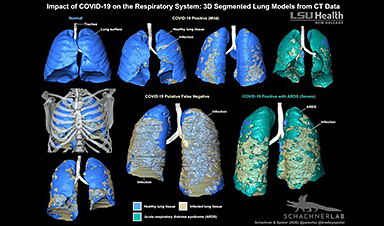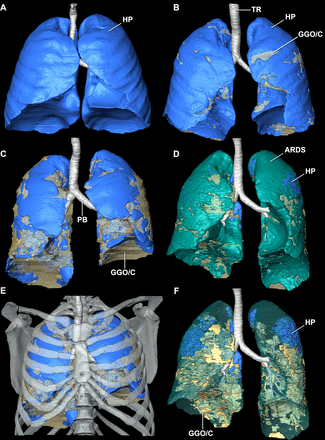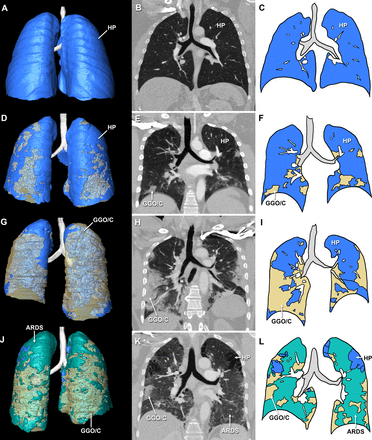Images Description
Three individuals were admitted to the hospital (ages 46–56; to men and one woman) with a multiday history of symptoms associated with the severe acute respiratory syndrome coronavirus 2 (SARS-CoV-2) and underwent contrast-enhanced thoracic CT due to worsening symptomatology. Three-dimensional (3D) digital models were created to visualise the extent of the disease within the respiratory system (figures 1 and 2) from the thin section (1 mm) data sets. All patients presented emergently with variable pulmonary symptoms ranging from mild to severe, including shortness of breath and all were febrile. Two of the patients were reverse transcription polymerase chain reaction (RT-PCR) positive for SARS-CoV-2 (figure 1B,D,F; figure 2C,D,G,H). The third patient was RT-PCR negative for SARS-CoV-2, but this was presumed to be a false-negative result given compelling clinical and imaging features indicative of COVID-19 (figures 1C,E and 2E,F). A fourth patient who presented to the emergency department and was suspected of having COVID-19 also underwent CT to assess for the possibility of pulmonary embolus (figures 1A and 2A,B). This individual tested negative for SARS-CoV-2, and the lungs were normal. All CT examinations were obtained using a Philips iCT 256 or iQon Spectral CT systems. Data were acquired using a 128×0.625 mm or 64×0.625 mm detector configuration with dual sampling, rotation time of 0.33 s (120 kVp 72 mAs).
Figure 1
Three-dimensional segmented surface models of normal, COVID-19 and suspected COVID-19 lungs in anterior view. (A) Healthy lung model of a 50-year-old man. (B) Lung model of a COVID-19-positive 46-year-old man with mild respiratory symptoms. (C) Lung model of a COVID-19-negative 56-year-old man with clinical suspicion for COVID-19. (D) Lung model of a COVID-19-positive 55-year-old woman with severe respiratory symptoms and ARDS. (E) C with a skeleton. (F) D but with the ARDS tissue made translucent to demonstrate the full extent of the ground glass opacities and consolidation throughout the parenchyma. ARDS, acute respiratory distress syndrome; C, consolidated infection; GGO, ground-glass opacities; HP, healthy parenchyma; PB, primary bronchus; TR, trachea. Colour key: blue, healthy tissue; yellow, consolidation and ground glass opacities; green, ARDS.
Figure 2
Three-dimensional (3D) segmented surface models of normal, COVID-19 and suspected COVID-19 lungs in posterior view (left) and coronal views with accompanying simplified diagrammatic illustrations of the coronal CTs demonstrating the infection sites. Healthy lungs of a 50-year-old man as a segmented 3D model in posterior view (A), a coronal contrast enhanced CT slice (B) and a diagrammatic illustration of B (C). COVID-19-positive 46-year-old man (mild respiratory symptoms) as a segmented 3D model in posterior view (D), a coronal contrast enhanced CT slice (E) and a diagrammatic illustration of E (F). Lungs of a COVID-19-negative 56-year-old man with clinical suspicion for COVID-19 as a segmented 3D model in posterior view (G), a coronal contrast-enhanced CT slice (H) and a diagrammatic illustration of H (I). Lungs of a COVID-19-positive 55-year-old woman with ARDS as a segmented 3D model in posterior view (J), a coronal contrast enhanced CT slice (K) and a diagrammatic illustration of K (L). Models demonstrate the relationship, distribution and full extent of the disease in 3D versus the single CT slice which only provides information on the localised position of the infection. ARDS, acute respiratory distress syndrome; C, consolidated infection; GGO, ground-glass opacities; HP, healthy parenchyma. Colour key: blue, healthy tissue; yellow, consolidation and ground glass opacities; green, ARDS. Images not to (relative) scale.
Image Credit: BMJ
News This Week
Scientists Melt Cancer’s Hidden “Power Hubs” and Stop Tumor Growth
Researchers discovered that in a rare kidney cancer, RNA builds droplet-like hubs that act as growth control centers inside tumor cells. By engineering a molecular switch to dissolve these hubs, they were able to halt cancer [...]
Platelet-inspired nanoparticles could improve treatment of inflammatory diseases
Scientists have developed platelet-inspired nanoparticles that deliver anti-inflammatory drugs directly to brain-computer interface implants, doubling their effectiveness. Scientists have found a way to improve the performance of brain-computer interface (BCI) electrodes by delivering anti-inflammatory drugs directly [...]
After 150 years, a new chapter in cancer therapy is finally beginning
For decades, researchers have been looking for ways to destroy cancer cells in a targeted manner without further weakening the body. But for many patients whose immune system is severely impaired by chemotherapy or radiation, [...]
Older chemical libraries show promise for fighting resistant strains of COVID-19 virus
SARS‑CoV‑2, the virus that causes COVID-19, continues to mutate, with some newer strains becoming less responsive to current antiviral treatments like Paxlovid. Now, University of California San Diego scientists and an international team of [...]
Lower doses of immunotherapy for skin cancer give better results, study suggests
According to a new study, lower doses of approved immunotherapy for malignant melanoma can give better results against tumors, while reducing side effects. This is reported by researchers at Karolinska Institutet in the Journal of the National [...]
Researchers highlight five pathways through which microplastics can harm the brain
Microplastics could be fueling neurodegenerative diseases like Alzheimer's and Parkinson's, with a new study highlighting five ways microplastics can trigger inflammation and damage in the brain. More than 57 million people live with dementia, [...]
Tiny Metal Nanodots Obliterate Cancer Cells While Largely Sparing Healthy Tissue
Scientists have developed tiny metal-oxide particles that push cancer cells past their stress limits while sparing healthy tissue. An international team led by RMIT University has developed tiny particles called nanodots, crafted from a metallic compound, [...]
Gold Nanoclusters Could Supercharge Quantum Computers
Researchers found that gold “super atoms” can behave like the atoms in top-tier quantum systems—only far easier to scale. These tiny clusters can be customized at the molecular level, offering a powerful, tunable foundation [...]
A single shot of HPV vaccine may be enough to fight cervical cancer, study finds
WASHINGTON -- A single HPV vaccination appears just as effective as two doses at preventing the viral infection that causes cervical cancer, researchers reported Wednesday. HPV, or human papillomavirus, is very common and spread [...]
New technique overcomes technological barrier in 3D brain imaging
Scientists at the Swiss Light Source SLS have succeeded in mapping a piece of brain tissue in 3D at unprecedented resolution using X-rays, non-destructively. The breakthrough overcomes a long-standing technological barrier that had limited [...]
Scientists Uncover Hidden Blood Pattern in Long COVID
Researchers found persistent microclot and NET structures in Long COVID blood that may explain long-lasting symptoms. Researchers examining Long COVID have identified a structural connection between circulating microclots and neutrophil extracellular traps (NETs). The [...]
This Cellular Trick Helps Cancer Spread, but Could Also Stop It
Groups of normal cbiells can sense far into their surroundings, helping explain cancer cell migration. Understanding this ability could lead to new ways to limit tumor spread. The tale of the princess and the [...]
New mRNA therapy targets drug-resistant pneumonia
Bacteria that multiply on surfaces are a major headache in health care when they gain a foothold on, for example, implants or in catheters. Researchers at Chalmers University of Technology in Sweden have found [...]
Current Heart Health Guidelines Are Failing To Catch a Deadly Genetic Killer
New research reveals that standard screening misses most people with a common inherited cholesterol disorder. A Mayo Clinic study reports that current genetic screening guidelines overlook most people who have familial hypercholesterolemia, an inherited disorder that [...]
Scientists Identify the Evolutionary “Purpose” of Consciousness
Summary: Researchers at Ruhr University Bochum explore why consciousness evolved and why different species developed it in distinct ways. By comparing humans with birds, they show that complex awareness may arise through different neural architectures yet [...]
Novel mRNA therapy curbs antibiotic-resistant infections in preclinical lung models
Researchers at the Icahn School of Medicine at Mount Sinai and collaborators have reported early success with a novel mRNA-based therapy designed to combat antibiotic-resistant bacteria. The findings, published in Nature Biotechnology, show that in [...]























